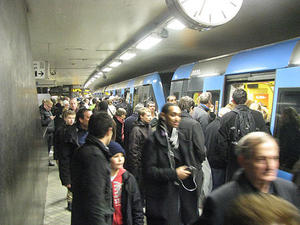NYC takes extra measures to protect subway from terror
The New York City’s subway system is a porous, 24-hour-a-day system with 468 stations and an average of 5 million riders a day; NYC security officials insist the city remains the nation’s No. 1 terror target, and they devote extra resources to protecting Wall Street, the Empire State Building, Brooklyn Bridge. and other high-profile potential targets; their biggest worry — spurred by the recent bombing in Moscow and a foiled plot in New York — is the subway

Typical rush hour in the subways // Source: streetsblog.org
You could not tell it from the outside: The tidy, three-story brownstone looks like any other on the cobblestone block in Brooklyn, but it is not. It is a fake, leading directly to the belly of the U.S. largest subway system.
Tom Hays reports that the unmarked emergency exit behind the innocent facade is one of many posts protected by beat cops defending New York City against bombings or other terror attacks in the city’s intricate underground mass transit network.
Since the 9/11 attacks, officials at the U.S. largest police department insist the city remains the nation’s No. 1 terror target, devoting extra resources to protecting Wall Street, the Empire State Building, Brooklyn Bridge. and other high-profile potential targets.
Perhaps the biggest worry — spurred by the recent bombing in Moscow and a foiled plot in New York — is the subway, a porous, 24-hour-a-day system with 468 stations and an average of 5 million riders a day.
Hays writes that authorities have employed bomb-sniffing dogs, high-tech explosive detection devices, and security cameras to protect the sprawling subway system. The NYPD’s counterterrorism division has sought to defend the subway by studying mass transit attacks in Madrid, London, Bombay and, most recently, Moscow to learn about the latest terror tactics.
Within hours of the Moscow suicide bombings, the department took the precaution of beefing up security at key transportation hubs throughout the city. “We look at how the devices were brought in,” said Inspector Martin Conway, counterterrorism coordinator for the NYPD’s transit bureau. “Was it liquid explosives? Remote detonation, with maybe a cell phone? A male suicide bomber? Female? … Anything that would give us some intelligence so we can adjust.”
“Few elements of urban infrastructure are more essential than the subways,” Police Commissioner Raymond Kelly said at a recent security briefing. “Protecting them is one of our top priorities and our greatest challenges.”
At the heart of the underground counterterrorism effort are transit officers who watch over fourteen subway tunnels for signs of suspicious activity. The officers work four-hour shifts on overtime, standing post in tiny guard booths that the NYPD erected on subway platforms after the 9/11 attacks. The booths, at the openings of the tunnels, are plastered with subway maps and have monitors fed by security cameras showing inside the tunnels.
The officers also receive the same training as subway workers on how to walk through the tunnels and avoid numerous hazards. Because of that, they have become familiar with a subway oddity: the town house emergency exit.
Located in the tunnel just east of the river, the exit leads to a grimy lit set of metal stairs that ascend past utility boxes and ventilation shafts into a bleak, windowless room with a door. Anyone opening the door would find themselves on a stoop — part of the facade replicating a town house.
The passageway once was only secured from the outside by a giant bolt in the middle of the door that was opened with a tire iron. It is now rigged with silent alarms and motion detectors that would alert police to an intruder.
“The security reflects concerns that a terrorist could use the passageway to sneak into the system, or try to tamper with the ventilation to make a chemical or biological attack more lethal,” Hays notes
